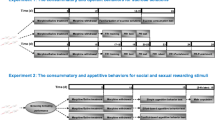Abstract
-
1.
On 9 nights (2000-0800) over a 25-day period, an anise-flavored aqueous solution of etonitazene, 5 mcg/ml, was provided as the sole drinking fluid for one group of physically dependent rats (MFETZ) maintained on morphine, 200 mg/kg i.p. once daily at 0800 (hence acutely abstinent each night) and for one group of saline-injected rats (SFETZ), while only anise-flavored water was available to comparable physically dependent (MFH2O) and saline-injected (SFH2O) groups.
-
2.
Beginning 3 days after abrupt and permanent termination of morphine or saline injections, all rats were tested at intervals over a period of 287 days on nocturnal (2000-0800) choice drinking from 2 tubes (positions alternated), one contained anise-flavored water and the other, plain water.
-
3.
Analyses of variance on the mean volumes of each of the two fluids consumed by each rat over blocks of choice-drinking tests revealed that through the VIIth test (137th post-injection day), MFETZ drank more anise-flavored water than any other group while there were no significant differences among the groups as regards consumption of plain water.
-
4.
The evidence indicates that the potency of secondary reinforcers so generated can persist long after morphine withdrawal. Some implications for problems of relapse and treatment of opioid addicts are discussed.
Similar content being viewed by others
References
Edwards, A. E.: Statistical Methods, 2nd ed., pp. 209–215. New York: Holt, Rinehart and Winston 1967.
Goldberg, S. R., Schuster, C. R.: Conditioned suppression by a stimulus associated with nalorphine in morphine-dependent monkeys. J. exp. Anal. Behav. 10, 235–242 (1967).
— —: Conditioned nalorphine-induced abstinence changes: persistence in postmorphine dependent monkeys. J. exp. Anal. Behav. 14, 33–46 (1970).
—, Woods, J. H., Schuster, C. R.: Morphine: conditioned increases in self-administration in rhesus monkeys. Science 166, 1306–1307 (1969).
Kelleher, R. T., Gollub, L. R.: A review of positive conditioned reinforcement. J. exp. Anal. Behav. 5 (4, Suppl.), 543–597 (1962).
Martin, W. R., Wikler, A., Eades, C. G., Pescor, F. T.: Tolerance to and physical dependence on morphine in rats. Psychopharmacologia (Berl.) 4, 247–260 (1963).
Nichols, J. R., Headlee, C. P., Coppock, H. W.: Drug addiction. I. Addiction by escape training. J. Amer. pharm. Ass., sci. Ed. 45, 788–791 (1956).
Schuster, C. R., Woods, J. H.: The conditioned reinforcing effects of stimuli associated with morphine reinforcement. Int. J. Addict. 3, 223–230 (1968).
Wikler, A.: On the nature of addiction and habituation. Brit. J. Addict. 57, 73–79 (1961).
—: Conditioning factors in opiate addiction and relapse. In: Narcotics, D. M. Wilner and G. G. Kassebaum, eds., pp. 85–100. New York: McGraw-Hill 1965.
—: Some implications of conditioning theory for problems of drug abuse. In: Drug Abuse. Data and Debate, P. H. Blachly, ed., pp. 104–113. Springfield, Ill.: Ch. C. Thomas 1970.
—, Green, C. P., Smith, H. D., Pescor, F. T.: Use of a dilute solution (5 mcg/ml) of a benzimidazole derivative with potent morphine-like actions orally as a presumptive reinforcing agent in conditioning of drug-seeking behavior in rats. Fed. Proc. 19, 22 (1960).
—, Martin, W. R., Pescor, F. T., Eades, C. G.: Factors regulating oral consumption of an opioid (etonitazene) by morphine-addicted rats. Psychopharmacologia (Berl.) 5, 55–76 (1963).
—, Pescor, F. T.: Classical conditioning of a morphine-abstinence phenomenon, reinforcement of opioid-drinking behavior and “relapse” in morphine-addicted rats. Psychopharmacologia (Berl.) 10, 255–284 (1967).
— —: Persistence of “relapse-tendencies” of rats previously made physically dependent on morphine. Psychopharmacologia (Berl.) 16, 375–384 (1970).
Winer, B. J.: Statistical Principles in Experimental Design, pp. 46–70. New York: McGraw-Hill 1962.
Woods, J. H., Schuster, C. R.: Reinforcement properties of morphine, cocaine and SPA as a function of unit dose. Int. J. Addict. 3, 231–237 (1968).
Author information
Authors and Affiliations
Additional information
This study was supported in part by USPHS grant no. MH 13194 of the National Institute of Mental Health, awarded to the Department of Psychiatry, University of Kentucky College of Medicine.
Formerly Biologist, NIMH Addiction Research Center, Lexington, Kentucky, U.S.A.
Rights and permissions
About this article
Cite this article
Wikler, A., Pescor, F.T., Miller, D. et al. Persistent potency of a secondary (conditioned) reinforcer following withdrawal of morphine from physically dependent rats. Psychopharmacologia 20, 103–117 (1971). https://doi.org/10.1007/BF00404365
Received:
Revised:
Issue Date:
DOI: https://doi.org/10.1007/BF00404365




